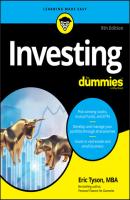Investing For Dummies. Eric Tyson
Чтение книги онлайн.

Читать онлайн книгу Investing For Dummies - Eric Tyson страница 17
Название: Investing For Dummies
Автор: Eric Tyson
Издательство: John Wiley & Sons Limited
Жанр: Личные финансы
isbn: 9781119716518
isbn:
Then there’s the issue of control. Flying seems more dangerous to some folks because the pilots are in control of the plane, whereas in your car, you can at least be at the steering wheel. Of course, you can’t control what happens around you or mechanical problems with the mode of transportation you’re using.
This doesn’t mean that you shouldn’t drive or fly or that you shouldn’t drive to the airport. However, you may consider steps you can take to reduce the significant risks you expose yourself to in a car. For example, you can get a car with more safety features, and you can choose to drive less aggressively and to minimize riding as a passenger with poor drivers.
Although some people like to live life to its fullest and take “fun” risks (how else can you explain mountain climbers, parachutists, and bungee jumpers?), most people seek to minimize risk and maximize enjoyment in their lives. The vast majority of people also understand that they’d be a lot less happy living a life in which they sought to eliminate all risks, and they likely wouldn’t be able to do so anyway.
You can’t live without taking risks. Risk-free activities or ways of living simply don’t exist. You can minimize but never eliminate all risks. Some methods of risk reduction aren’t palatable because they reduce your quality of life. Risks are also composed of several factors. In the sections that follow, I discuss the various types of investment risks and go over proven methods you can use to sensibly reduce these risks while not missing out on the upside that growth investments offer.
Market-value risk
Although the stock market can help you build wealth, most people recognize that it can also drop substantially — by 10, 20, or 30 percent (or more) in a relatively short period of time. That’s an example of market-value risk – that is, the risk that the value of an investment can decline.
After hitting a new all-time high in February 2020, the U.S. stock market got clobbered by COVID-19–related concerns and containment measures that impeded people’s travel and other activities and ended up leading to a sharp, short-term recession. In a little over one month, from peak to bottom, the Dow Jones Industrial Average plunged 36 percent.
After peaking in 2000, U.S. stocks, as measured by the large-company S&P 500 index, dropped about 50 percent by 2002. Stocks on the NASDAQ, which is heavily weighted toward technology stocks, plunged more than 76 percent from 2000 through 2002!
After a multi-year rebound, stocks peaked in 2007, and then dropped sharply during the “financial crisis” of 2008. From peak to bottom, U.S. and global stocks dropped by 50-plus percent.
In a mere six weeks (from mid-July 1998 to early September 1998), large-company U.S. stocks fell about 20 percent. An index of smaller-company U.S. stocks dropped 33 percent over a slightly longer period of two and a half months.
If you think that the U.S. stock market crash that occurred in the fall of 1987 was a big one (the market plunged 36 percent in a matter of weeks), take a look at Table 2-1, which lists major declines over the past 100-plus years that were all as bad as or worse than the 1987 crash.
Real estate exhibits similar unruly, annoying tendencies. Although real estate (like stocks) has been a terrific long-term investment, various real estate markets get clobbered from time to time.
U.S. housing prices took a 25 percent tumble from the late 1920s to the mid-1930s. When the oil industry collapsed in the southern United States in the early 1980s, real estate prices took a beating in that area. Later in the 1980s and early 1990s, the northeastern United States became mired in a severe recession, and real estate prices fell by 20-plus percent in many areas. After peaking near 1990, many of the West Coast housing markets, especially those in California, experienced falling prices — dropping 20 percent or more in most areas by the mid-1990s. The Japanese real estate market crash also began around the time of the California market fall. Property prices in Japan collapsed more than 60 percent.
TABLE 2-1 Largest U.S. Stock Market Declines*
| Period | Size of Fall |
|---|---|
| 1929–1932 | 89% (ouch!) |
| 2007–2009 | 55% |
| 1937–1942 | 52% |
| 1906–1907 | 49% |
| 1890–1896 | 47% |
| 1919–1921 | 47% |
| 1901–1903 | 46% |
| 1973–1974 | 45% |
| 1916–1917 | 40% |
| 2000–2002 | 39% |
| 2020 | 36% |
* As measured by changes in the Dow Jones Industrial Average
Declining U.S. housing prices in the mid- to late 2000s garnered unprecedented attention. Some folks and pundits acted like it was the worst housing market ever. Foreclosures increased in part because of buyers who financed their home purchases with risky mortgages (which I recommend avoiding in my books, including this one — see Chapter 12). I must note here that housing market conditions vary by area. For example, some portions of the Pacific Northwest and South actually appreciated during the mid- to late 2000s, while other markets experienced substantial declines.
After reading this section, you may want to keep all your money in the bank — after all, you know you won’t lose your money, and you won’t have to be a nonstop worrier. Since the FDIC came into existence in 1933, no one has lost 20, 40, 60, or 80 percent of his bank-held savings vehicle within a few years (major losses prior to then did happen, though). But just letting your money sit around would be a mistake.